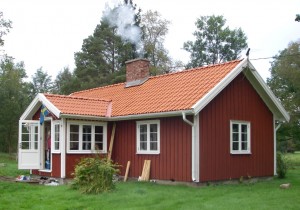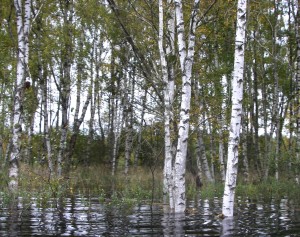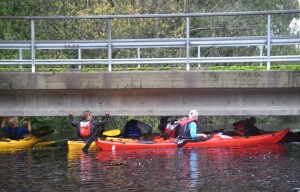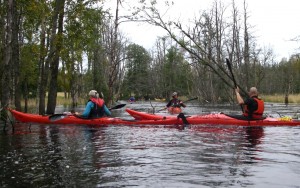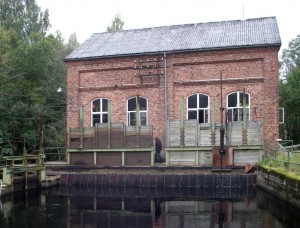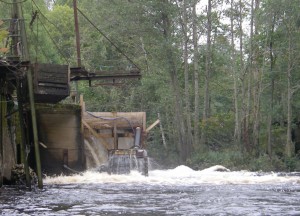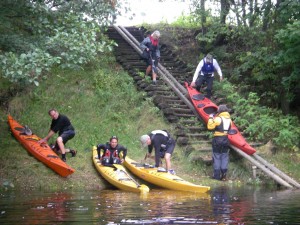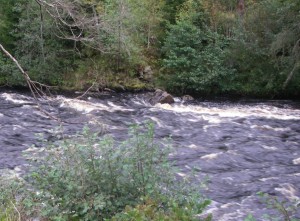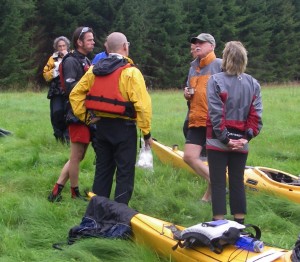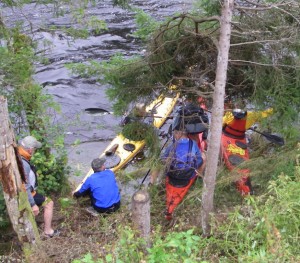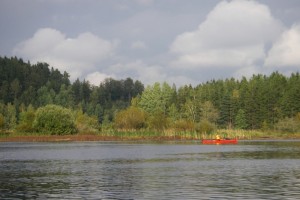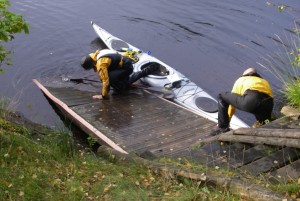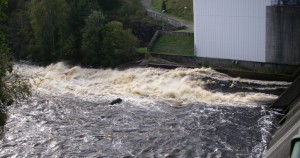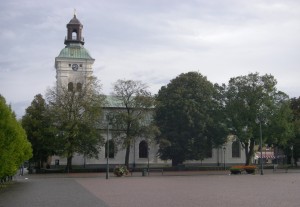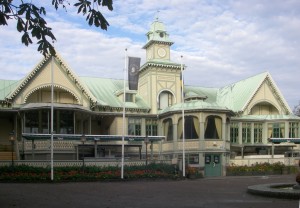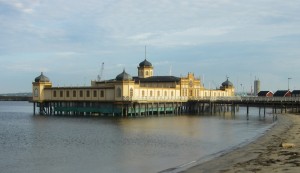Our tour started on the Lilleäen which flows northwards to meet the Ätran flowing almost parallel southward. It eventually drains to the sea at Falkenberg on the Swedish west coast. Our base was a small wooden cottage, called a torp in Scandinavia, conveniently placed close to the end of our tour and not far from the beginning, 10 m higher. Thus we could slide down with the current.
The route can be followed on this map: http://www.svenskkanoferie.dk/download/kort_2_big.pdf (12Mb!)
There had been much rain, so the river was running high, which presented paddlers used to the open sea with an unusual demand on their flexibility.
Fallen trees provided a similar stress test to paddlers who allowed the water flow to pin them against the obstruction.
A more serious obstacle was provided by hydro electric turbines which we had to bypass on foot.
The Lilleäen is a pleasant small river lined with alder and birch trees, passing through forests ravaged by a recent storm.
After its almost imperceptible merger with the larger Ätran the river widens and becomes less interesting, until one comes to a short grade 2 rapid.
This was our lunch stop, short and held standing in a light drizzle.
For a tour of 37 km, a generous lunch stop would have been better, but we pushed on, carrying kayaks over branches and through puddles to the set-in point below the rapids.
We got rather strung out towards the end of a long paddle. Here we tail-enders are puzzled which way to go as the river enters the lake formed by the dam for the second hydro power plant.
Fortunately the river was running higher than necessary to feed the turbines, so the roar from the water rushing down the spillway indicated a right turn.
The take out is close above the dam. If one misses it there is an exciting grade 6 adventure.
Dinner back at the torp was in typical Scandinavian style, gathered tight packed around a table, with a 10kW wood burner warming the modest dining room so energetically that I chose to sit in the farthest corner.
After decades living in Denmark I have not really learned to enjoy the long drawn out evening ceremony of eating, drinking and small talk sitting at a table. However, I thought I had learned to relax and let more fluent folk keep up the ping pong exchange of mild witticisms, but as the dessert arrived I overheated then fainted during a too long delayed flight towards the cool of the Swedish autumn landscape.
Fortunately, my companions have multiple skills including first aid, so I was revived and sent off to experience the Swedish welfare state’s admirable health service. After a long ambulance trip to Varberg hospital the cause of my low blood pressure was investigated as I spontaneously recovered.
Judged fit early the next morning, I found myself looking mournfully at the violent rainstorm flooding the hospital entrance. Not blessed with a smart phone, I had wrongly guessed that the first train towards Denmark would be soon after eight. The taxi deposited me at the station which was closed until nine thirty. The first train south was at 1020.
As the rain abated and the sun slowly forced itself through the mist I wandered the deserted Sunday morning streets and discovered a spacious and elegant town which also was a centre for water sport: the 19th century spa culture of sipping tea to the sound of a string orchestra and submerging oneself in cool sea water for therapeutic restoration.
As I wandered, the town woke up: first the runners in sporty tights, then the elderly pairs exercising their dogs, then the cyclists. A touching scene of small town life on an autumn Sunday morning. By fortunate chance I found the tiny early-opening cafe of the cold bath house, a lovely 19th century (reconstructed) structure on piles in the harbour, providing discreetly screened submersion facilities.
So my frightening, but brief indisposition brought me to a charming town which I would otherwise not have thought of visiting.
My warm thanks to my sympathetic companions from the Vedbæk kayak club, particularly to Birgitte and Martin and to those who dismantled my hermit’s hammock strung between the ideally spaced oak trees that graced the clearing around the cottage.
tim
